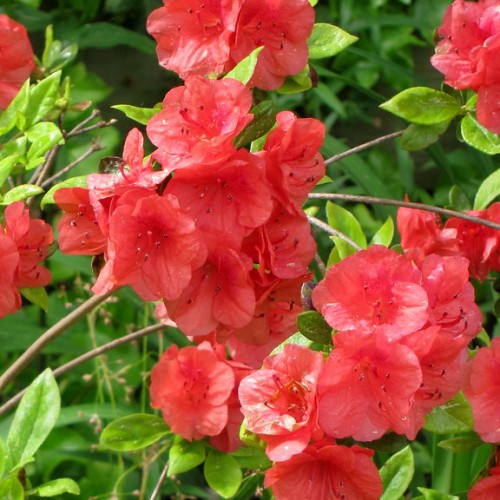
evergreen azalea
Rhododendron 'Hino-crimson'
Cycle:
Perennial
Watering:
Average
Hardiness Zone:
5 - 8
Flowers:
Flowers
Sun:
Part shade
Leaf:
Yes
Growth Rate:
High
Maintenance:
Moderate
Poisonous To Pets:
Yes
watering
Evergreen azalea (Rhododendron 'Hino-crimson') should be watered deeply and evenly, about once per week. It prefers moist but well-drained soil and should not be allowed to dry out completely between waterings. A good way to gauge the moisture level is to stick your finger an inch or 2 into the soil. If your finger comes out wet, the plant does not need water. If your finger comes out dry, it’s time to water. Also, it is important to note that while they enjoy moist soil, they will not do well when sitting in water. Feel the soil around the base of the plant, and if it is damp, then you don’t need to water. In the dry summer months, you may need to water twice per week or more often. During the winter, water less frequently, about once every 2 weeks, as the plant does not need as much moisture when it is dormant.
sunlight
Evergreen azalea (Rhododendron 'Hino-crimson') needs full sun to partial shade. The amount of sunlight this species needs varies depending on where it is grown and the time of year. In cooler climates, the evergreen azalea will do best in partial shade, but in warmer climates, it will do well with full sun exposure. The intensity of the sunlight should be moderate and not too intense or long lasting as it can cause damage to the plant. In general, the plants should receive at least 4 hours of direct sunlight per day. If the plant receives more than 8 hours of direct sunlight per day, additional shade should be provided for the plant.
pruning
Evergreen azalea (Rhododendron 'Hino-crimson') should be pruned once a year in early spring. Start pruning at the base of the plant, removing any branches that are dead, diseased, or damaged, and thinning the interior of the plant to provide air circulation. Make sure to leave a few buds on each branch while pruning, as these become the flowers buds for the following year. Once pruning is complete, use a slow-release fertilizer to supplement any nutrients lost from pruning.
